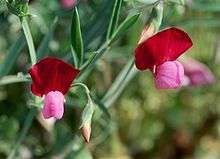Lathyrus clymenum
Lathyrus clymenum, also called Spanish vetchling,[2] is a flowering plant in the family Fabaceae, native to the Mediterranean. The seeds are used to prepare a Greek dish called fava santorinis. The plant is cultivated on the island of Santorini in Greece and was recently added to the European Union's products with a Protected Designation of Origin.
| Lathyrus clymenum | |
|---|---|
 | |
| Scientific classification | |
| Kingdom: | |
| (unranked): | |
| (unranked): | |
| (unranked): | |
| Order: | |
| Family: | |
| Subfamily: | |
| Genus: | |
| Species: | L. clymenum |
| Binomial name | |
| Lathyrus clymenum | |
| Synonyms[1] | |
| |

For 3,500 years residents of Santorini and neighbouring islands have been cultivating the legume species Lathyrus clymenum, known elsewhere only as a wild plant.[3] The peculiar ecosystem that was created by the volcanic explosions on Santorini island, the volcanic ash, the cellular soil, and the combination of humidity created by the sea and the drought, make the bean a unique resource. When weather conditions are good farmers on the island can reap about 800 kilos of beans per hectares. A vulnerable crop, it can be destroyed by strong winds that blow away its flowers before they can yield the pea, by drought or by a sudden heat wave almost instantly. Its production is thus limited making it an expensive crop that costs €700 per acre. The cost for consumers is about €9-10 per kilo.
Fava santorinis
The cooked fava are mixed with chopped onion into a purée, typically served with chopped onion, olive oil and lemon juice.
Nutrient content
The plant Lathyrus Clymenum which the 'Fava Santorinis' is made of, has very high content of Protein (25%)and is an excellent source of dietary Fibre (26%). It is very low on Fat as most of its Carbohydrates derive from Complex Carbohydrates and Protein.
Although it looks like the Indian 'Toor Dal' or 'Chana Dal', it is a completely different species with much higher nutritional value.
There is historical evidence that pulses and in particular wild lentils started being cultivated in Greece in 6.000 BC. The Greek microclimate has been ideal for the evolution of such crops and the Greeks have mastered their cooking and have benefited from their high nutritional value that comes in low cost to survive wars and famines throughout history.
References
| Wikimedia Commons has media related to Lathyrus clymenum. |
- "The Plant List: A Working List of All Plant Species". Retrieved 7 March 2015.
- "Lathyrus clymenum". Germplasm Resources Information Network (GRIN). Agricultural Research Service (ARS), United States Department of Agriculture (USDA). Retrieved 7 March 2015.
- Anaya Sarpaki, Glynis Jones, "Ancient and Modern Cultivation of Lathyrus clymenum L. in the Greek Islands" in Annual of the British School at Athens vol. 85 (1990) pp. 363-368 JSTOR
- Georgiopoulou, Tania. "Demand for Santorini fava outstrips supply". www.ekathimerini.com. Archived from the original on 2011-12-02. Retrieved 2013-01-06.
- "Συνταγή για Φάβα". www.santoriniinfo.gr.
- "Fava Santorinis". kopiaste.org.